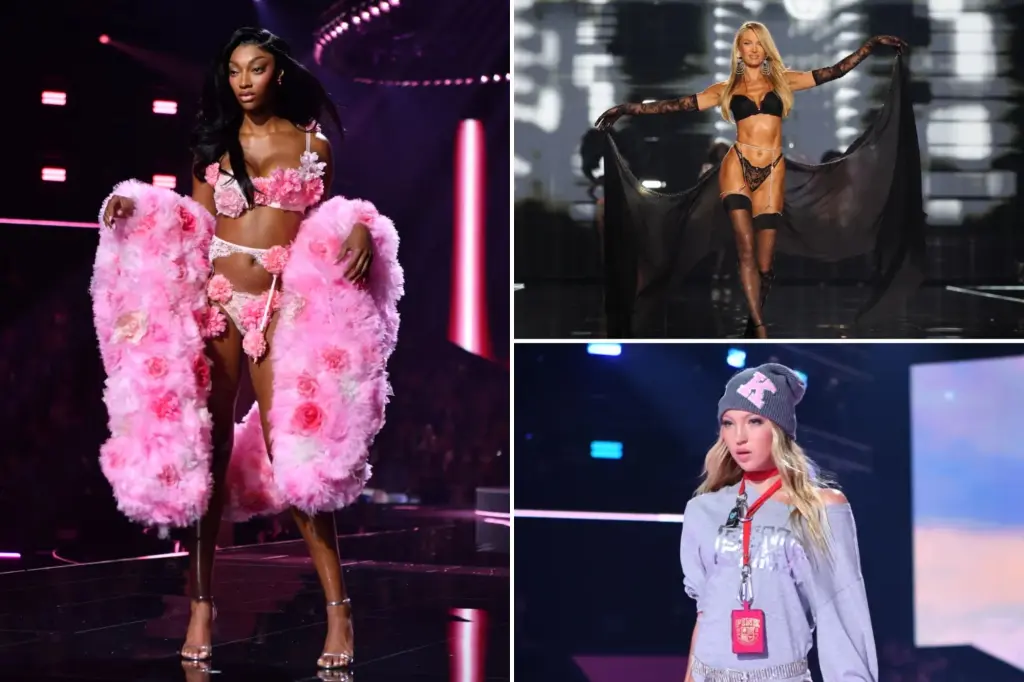The 2025 Victoria’s Secret Fashion Show: Rebirth or Regression?
The 2025 Victoria’s Secret Fashion Show made its anticipated second-year return at the Brooklyn Navy Yard, carrying the weight of high expectations. With the brand’s stock price down over 30% in less than a year and a history of controversy still lingering, Victoria’s Secret desperately needed this show to mark a turning point. The event aimed to recapture the magic of its heyday while addressing the criticisms that led to its 2019 cancellation—declining ratings, lack of diversity, and the lukewarm reception of last year’s comeback attempt. The runway featured the traditional spectacle of feathers and dramatic wings, but the question remained: would these familiar elements be enough to revitalize a struggling brand in a changed cultural landscape?
Public reaction to the show proved deeply polarized, reflecting broader tensions about beauty standards and representation in fashion. Social media erupted with conflicting opinions—some viewers celebrated the return to the fantasy-driven aesthetics of the early 2000s, while others questioned whether Victoria’s Secret had learned anything from its time away from the spotlight. The inclusion of athletes like gymnast Suni Lee and WNBA player Angel Reese drew both praise and confusion. “It went from Candace Swanepoel and Adriana Lima, to like…who is that?” remarked 21-year-old Sabrina Zeki to The Post, capturing the sentiment of those who missed the supermodel-dominated lineups of previous years. Many traditionalists agreed with Zeki’s assessment that “Victoria’s Secret going back to their traditional, early 2000s roots is what everybody really wants.”
Critics, however, were quick to question the brand’s attempt at rehabilitation. “Given Victoria’s Secret’s insanely problematic past, I’m honestly shocked they are trying to rebrand that f—g garbage bag corporation…” wrote one user on X. Others directly addressed the body types still dominating the runway: “Why is Victoria’s Secret still glorifying 6-foot-tall models that weigh 110 lbs?? They look sick and frail.” The show’s Pink segment particularly sparked debate, featuring influencers like Gabriela Moura and celebrity offspring like Iris Law, daughter of Jude Law and Sadie Frost. This casting choice led to comments like “Whoever’s recruiting ‘models’ for the show needs to be let go. I don’t need to see ‘socially relevant’ ppl on the runway. VS has always been SUPER MODELS, not randos,” and “Their job is to be content creators; they can just get invited….let the supermodels do their job.”
The tension between tradition and progress created an impossible balancing act for Victoria’s Secret. The show attempted to simultaneously satisfy those yearning for the nostalgic glamour of supermodels while appeasing calls for greater diversity and inclusivity. In trying to bridge these competing demands, the production risked satisfying neither audience completely. Some viewers welcomed the broader representation and celebrated seeing women from various backgrounds and body types on the runway. But for others, this diversification diluted what they considered the core appeal of the Victoria’s Secret brand—what Zeki described as “the OG supermodel, gorgeous, unattainable look. That’s the whole appeal of the show, the fantasy they are selling.”
Victoria’s Secret’s struggle to redefine itself comes after years of damaging controversies that alienated consumers and damaged its brand image. Between 2018 and 2022, the company faced multiple crises: former marketing chief Ed Razek’s fatphobic and transphobic comments, a New York Times exposé on ex-CEO Les Wexner’s ties to Jeffrey Epstein (which Wexner later denied), and an $8.3 million settlement with garment workers over unpaid wages. These incidents weren’t merely PR problems but symptoms of deeper issues with the brand’s culture and values. Though the company has since installed new leadership and promised substantial changes, the 2025 show revealed how difficult it is to evolve while retaining the elements that made the brand successful in the first place.
The divided response to the 2025 Victoria’s Secret Fashion Show ultimately reflects broader societal tensions about beauty, inclusion, and representation. Fashion brands today face the challenge of balancing commercial appeal with ethical responsibility, nostalgic glamour with progressive values. For Victoria’s Secret, the path forward remains unclear. While some viewers will always prefer the fantasy-driven approach that defined the brand’s peak years, others demand a more inclusive vision that reflects the diverse reality of women’s bodies and experiences. As one of fashion’s most iconic institutions attempts to navigate this complex terrain, the question remains whether Victoria’s Secret can find a formula that satisfies both its legacy audience and the cultural expectations of today—or if the era of the traditional fashion show spectacle has fundamentally passed. The brand’s future may depend not just on beautiful models and elaborate wings, but on convincing consumers that its evolution is genuine rather than merely performative.


